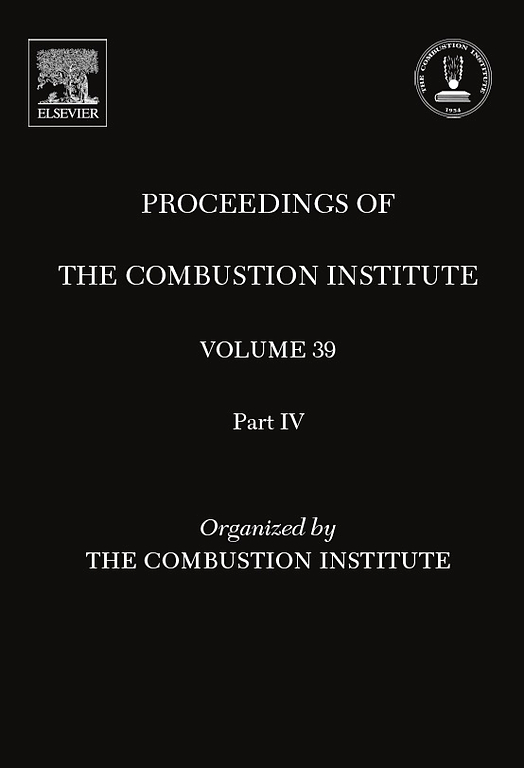The behaviour of NH[formula omitted]/H[formula omitted]/N[formula omitted], CH[formula omitted] and C[formula omitted]H[formula omitted] turbulent premixed bluff-body stabilized flames near lean blow-off
IF 5.2
2区 工程技术
Q2 ENERGY & FUELS
引用次数: 0
Abstract
The lean blow-off (LBO) behaviour of turbulent premixed bluff-body stabilized flames was investigated. Fuels with a range of Lewis numbers were used to examine differential diffusion characteristics, including NH/H/N (70%/22.5%/7.5% by volume), CH and CH. Simultaneous OH-PLIF and PIV were employed to study flame structure changes as the flames approach LBO, and quantify curvature and hydrodynamic strain rates along the flame surface. Large Eddy Simulation (LES) was also conducted to quantify the consumption rates of each fuel at some time before and during the blow-off transient. At moderate inlet velocities the ammonia blended flames are more resilient to LBO in comparison with the methane and propane flames. The flame structure of the ammonia blended flames is much more fragmented than the hydrocarbon flames, even relatively far from LBO, with a higher intensity heat release rate distribution close to the flame base. Higher positive flame curvatures were observed in the ammonia blended flames, which is likely to contribute to the strong anchoring of these flames even in regions of high strain close to the flame base. The consumption rate for these flames is shown to increase locally near the flame base when approaching LBO. Furthermore, the lower strain rates experienced on the surface of NH/H/N flame compared with the other two flames may also delay blow-off. The CH-air flames feature more spatial regions along the shear layers with predominantly negative curvature, which can also enhance the reaction due to the Lewis number of these flames exceeding unity. However in these flames the consumption rate decreases locally in the highly strained regions when ramping to LBO, potentially contributing to their lower relative LBO resilience. For CH-air flames, the curvature, hydrodynamic strain rates and consumption rates do not change much when ramping to LBO, which offer no input to modify the LBO.NH[式省略]/H[式省略]/N[式省略]、CH[式省略]和 C[式省略]H[式省略]湍流预混合吹胀体稳定火焰在贫吹散附近的行为
研究了湍流预混合崖体稳定火焰的贫化吹脱(LBO)行为。使用了一系列路易斯数的燃料来研究不同的扩散特性,包括 NH/H/N(70%/22.5%/7.5%(体积比))、CH 和 CH。同时采用 OH-PLIF 和 PIV 来研究火焰接近 LBO 时的火焰结构变化,并量化火焰表面的曲率和流体动力应变率。此外,还进行了大涡流模拟(LES),以量化吹脱瞬态之前和期间一段时间内每种燃料的消耗率。与甲烷和丙烷火焰相比,在中等进口速度下,氨混合火焰对 LBO 的抵抗力更强。氨气混合火焰的火焰结构比碳氢化合物火焰更分散,即使离 LBO 较远,靠近火焰底部的热释放率分布强度也更高。在氨气混合火焰中观察到了更高的正火焰曲率,这可能是这些火焰即使在靠近焰底的高应变区域也能牢固锚定的原因。当接近 LBO 时,这些火焰在焰基附近的消耗率会增加。此外,与其他两种火焰相比,NH/H/N 火焰表面的应变率较低,这也可能会延迟吹脱。CH-air 火焰的特点是沿剪切层有更多的空间区域主要为负曲率,由于这些火焰的路易斯数超过了统一值,这也会增强反应。然而,在这些火焰中,当升温到 LBO 时,高应变区域的局部消耗率会降低,这可能是其相对 LBO 复原力较低的原因。对于 CH-空气火焰,当升温至 LBO 时,曲率、流体动力应变率和消耗率变化不大,因此无法对 LBO 进行修改。
本文章由计算机程序翻译,如有差异,请以英文原文为准。
求助全文
约1分钟内获得全文
求助全文
来源期刊

Proceedings of the Combustion Institute
工程技术-工程:化工
CiteScore
7.00
自引率
0.00%
发文量
420
审稿时长
3.0 months
期刊介绍:
The Proceedings of the Combustion Institute contains forefront contributions in fundamentals and applications of combustion science. For more than 50 years, the Combustion Institute has served as the peak international society for dissemination of scientific and technical research in the combustion field. In addition to author submissions, the Proceedings of the Combustion Institute includes the Institute''s prestigious invited strategic and topical reviews that represent indispensable resources for emergent research in the field. All papers are subjected to rigorous peer review.
Research papers and invited topical reviews; Reaction Kinetics; Soot, PAH, and other large molecules; Diagnostics; Laminar Flames; Turbulent Flames; Heterogeneous Combustion; Spray and Droplet Combustion; Detonations, Explosions & Supersonic Combustion; Fire Research; Stationary Combustion Systems; IC Engine and Gas Turbine Combustion; New Technology Concepts
The electronic version of Proceedings of the Combustion Institute contains supplemental material such as reaction mechanisms, illustrating movies, and other data.
 求助内容:
求助内容: 应助结果提醒方式:
应助结果提醒方式:


